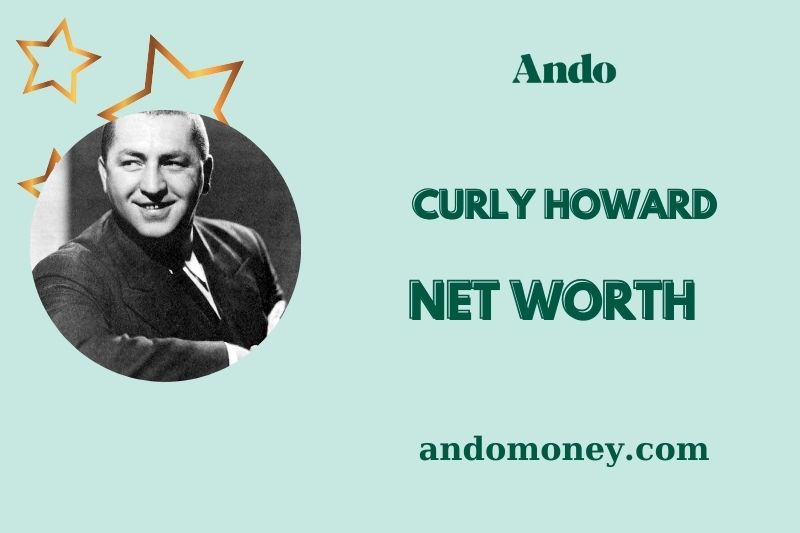Did Curly Howard make millions from his comedic genius? As one of the most iconic members of The Three Stooges, Curly entertained audiences with his slapstick humor and unforgettable catchphrases.
However, behind the laughter was a financial story shaped by Hollywood contracts, extravagant spending, and health struggles.
In this article, Ando explores Curly Howard net worth, wealth, and financial history. From his earnings with Columbia Pictures to the impact of his declining health, we’ll uncover the real story behind his fortune.
Curly Howard Quick Facts

| FACT | DETAIL |
|---|---|
| Real Name | Jerome Lester Horwitz |
| Popular Name | Curly Howard |
| Birth Date | October 22, 1903 |
| Age | Died: January 18, 1952 (age 48 years) |
| Birthplace | Brooklyn, New York, USA |
| Nationality | American |
| Ethnicity | Lithuanian Jewish |
| Education | Did not graduate high school |
| Marital Status | Married 4 times |
| Spouse | Julia Rosenthal (m. 1930; div. 1931) Elaine Ackerman (m. 1937; div. 1940) Marion Buxbaum (m. 1945; div. 1946) Valerie Newman (m. 1947) |
| Children | Janie Howard, Marilyn Howard |
| Dating | Several relationships |
| Siblings | Moe Howard, Shemp Howard, and others |
| Parents | Jennie (Gorovitz) and Solomon Horwitz |
| Height | 1.65 m |
| Net Worth | $1 million (at time of death, 1952) |
| Source of Wealth | Acting, Comedy (The Three Stooges) |
What is the Net Worth of Curly Howard in 2025?

Curly Howard’s net worth was estimated at $1 million at the time of his death in 1952, which would be around $10 million today when adjusted for inflation.
Compared to other Hollywood comedians of his era, Curly’s earnings were substantial, but they paled in comparison to modern-day actors. Unlike contemporary comedians who benefit from residuals and syndication deals, Curly and The Three Stooges had fixed salaries that limited their long-term financial gains.
Related People & Companies
- Moe Howard
- Larry Fine
- Shemp Howard
- Ted Healy
- Columbia Pictures
- Jules White
- Vaudeville industry
- Classic Hollywood actors
- Comedic performers
- The Three Stooges
Interested in exploring more about the highest-earning entertainers in history? Check out the top wealthiest entertainers.
Curly Howard Wealth, Salary, and Financial Overview

How Did Curly Howard Earn His Wealth?
Curly Howard’s fortune was built primarily through his work in The Three Stooges. The trio’s success in vaudeville led them to sign with Columbia Pictures, where they produced nearly 200 short films.
While today’s comedians earn from multiple revenue streams, Curly’s wealth came from:
- Vaudeville tours – Early-stage performances before Hollywood fame.
- Columbia Pictures contracts – The Stooges’ primary source of income.
- Live performances – Supplemented their earnings during studio breaks.
Unlike modern actors who receive royalties, Curly and his team were paid a flat rate per short film without future earnings.
Salary and Earnings Throughout His Career
Curly earned approximately $2,500 per short film at Columbia Pictures—a significant amount for the time. However, his salary was dictated by Harry Cohn, Columbia’s president, who kept The Three Stooges under strict contracts.
Comparing his earnings:
- Charlie Chaplin and Buster Keaton made significantly more due to their control over their films.
- Abbott and Costello transitioned to feature films, earning much higher payouts.
Despite his popularity, Curly never had the opportunity to negotiate higher salaries due to his studio contract.
Curly Howard’s Spending Habits and Financial Management
Despite earning well, Curly was known for extravagant spending. His money went towards:
- Real estate – Constantly buying and selling houses, often at a loss.
- Nightlife – Enjoyed partying, expensive meals, and alcohol.
- Generosity – Gave money freely, making him vulnerable to financial losses.
His brother, Moe Howard, stepped in to manage his finances, preventing him from going completely broke.
The Financial Impact of Curly Howard’s Health Problems
Curly’s financial troubles worsened after his first stroke in 1946. With medical bills piling up, his income significantly declined as he stepped away from acting.
Key financial impacts:
- Medical costs – Treatment for strokes and long-term care.
- Lost income – No more film earnings after his health declined.
- Final years – Spent in hospitals, with Moe handling expenses.
Had he lived in today’s era, health insurance and residuals might have helped sustain his finances.
The Influence of Columbia Pictures on Curly Howard’s Financial Life
Curly’s financial fate was tied to Columbia Pictures, which:
- Paid The Three Stooges a fixed salary.
- Refused to let them make feature-length films.
- Profited from their success while keeping their wages low.
Unlike actors who receive royalties, Curly never saw a share of the millions in revenue generated by reruns.
Legacy and Posthumous Financial Impact
Even after his death, Curly Howard’s brand continued generating income. His legacy was sustained by:
- TV syndication – Reruns of The Three Stooges.
- Merchandise – DVDs, collectibles, and licensing deals.
- Tributes & biopics – Keeping his memory alive in pop culture.
Unfortunately, he did not directly benefit from the financial success of The Three Stooges beyond his lifetime.
Conclusion
Curly Howard’s financial journey was a mix of success and struggle. While he earned well, his spending habits and lack of royalties meant his wealth didn’t last beyond his lifetime. Despite this, his legacy as one of Hollywood’s greatest comedic talents remains strong.
Want to explore more celebrity finances? Visit andomoney.com for the latest insights!

